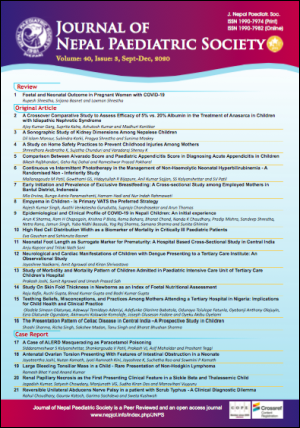Empyema in Children - Is Primary VATS the Preferred Strategy
DOI:
https://doi.org/10.3126/jnps.v40i3.29534Keywords:
Empyema thoracis, Pleural fluid cytology, Video Assisted Thoracoscopic SurgeryAbstract
Introduction: Empyema thoracis (ET) is an accumulation of pus in the pleural space. Considering the advantages of Video Assisted Thoracoscopic surgery (VATS), including reduced length of hospitalisation, lower postoperative morbidity and mortality, VATS is the treatment of choice for cases of stage 3 empyema. The objective of this study was to study the age-sex profile, clinical presentation, etiologic agents, management and the overall treatment outcome of empyema thoracis after early VATS in children.
Methods: This was a retrospective observational study, conducted in the Department of Paediatrics, Rangadore Memorial Hospital, Bangalore, from November 2018 to March 2020. All children in the age group of 0 to 18 years diagnosed to have pyogenic empyema and presenting in stage 1 and 2 during the study period were included in the study. In the present study, 15 children were found to be having empyema (stage 1 and 2).
Results: Majority of patients (66.6%) were seen in the age group of one to five years. Fever (100%), breathlessness (66.66%), and cough (80%) were the commonest presenting features. Bacteriological isolation was possible only in three cases (20%). Patients were treated with antibiotics and primary VATS in majority of cases (55.33%). Average duration of hospital stay in VATS group was 12.11 days.
Conclusions: Empyema thoracis mainly affects younger children. Common presenting features are fever, difficulty in breathing and cough. Appropriate antibiotics and early VATS may be acceptable modality for management of pyogenic empyema thoracis in children.
Downloads
Downloads
Published
How to Cite
Issue
Section
License
Authors who publish with this journal agree to the following terms:
Authors retain copyright and grant the journal right of first publication with the work simultaneously licensed under a Creative Commons Attribution License that allows others to share the work with an acknowledgement of the work's authorship and initial publication in this journal.
Authors are able to enter into separate, additional contractual arrangements for the non-exclusive distribution of the journal's published version of the work (e.g., post it to an institutional repository or publish it in a book), with an acknowledgement of its initial publication in this journal.
Authors are permitted and encouraged to post their work online (e.g., in institutional repositories or on their website) prior to and during the submission process, as it can lead to productive exchanges, as well as earlier and greater citation of published work (See The Effect of Open Access).



